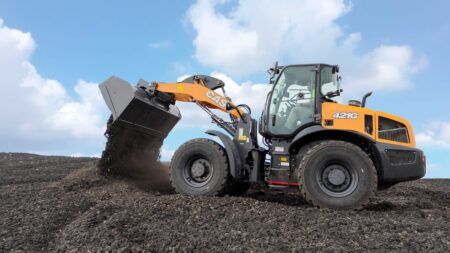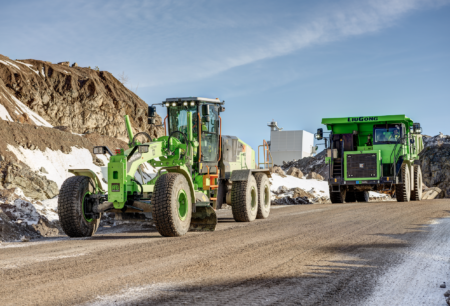Haulotte used Intermat to present its new range of Tier 4 Final telehandlers, which bring a wide range of innovations to the market.
With lifting capacities of up to 9000 lb (4 tons) and lifting heights up to 17m, the HTL telehandlers can be rapidly fitted with multiple accessories (quick-fits) including forks, simple or toothless buckets, work tools, hooked brackets, and side-mounted work tool containers. These offer excellent maneuverability, excellent work autonomy and numerous advantages.
Thanks to their standard equipment, HTL telehandlers offer excellent stability, regardless of the terrain surface, and this lateral stability is the combined result of the automatic locking of the rear deck rotation and the limitation of progressive movement and rearward travel. This combination prevents any adverse dynamic effects on the machine and therefore increases the stability on any terrain.
The 14m and 17m models also have a lateral tilt corrector for extra stability. The two forward stabilisers reinforce this stability in all working configurations. Their ability to operate independently allows them to rapidly adapt to all types of terrains at any time.
The Haulotte Group is breaking new ground and raising performance levels for standard equipment with a rear deck locking system, thus reinforcing its stability. This stiffening of the two axles more than doubles the usual stabilisation surface.
The telehandlers assist the operator in all operating positions with numerous visual and sound indicators. The travel and worksite modes, clearly identified, make maneuvering safer by avoiding any possible confusion. With the assistance of all of these control indicators covering overloading, stability, reversing the operator can truly focus on the work at hand.
Because comfort is so important for all-day driving. Haulotte has made ergonomics a priority of the new design. All controls have been specifically positioned for easier access according to their frequency of use. The joystick Smart Control includes all boom functions for precision work. The cabs are ROPS and FOPS fitted, spacious, sound-proofed, and easy to access. They are fitted with every feature to ensure operator comfort, including ventilation, air conditioning (optional), adjustable seats and storage space.
A backlit electronic dashboard centralizes all information about the operating status of the machine for continuous monitoring. Finally the load moment indicator (LMI), which is ideally positioned to be easily read in head high position, includes an automatic cut off when operating with a tilting risk. This new generation of LMI is intelligently managed by a CPU, which allows increased operating precision and also enables the operator to manually reset the system without the need for any tools. Thanks to this improvement, there is no need to call a field technician reducing both downtime and expense.
The integration of the latest technologies significantly facilitates the driving of telehandlers as the user can control both its action and its environment. The hydrostatic transmission combines optimal torque, power and speed for an unequalled driving comfort, and the inching pedal is ideal for smooth driving for an easy approach to a structure.
The flow-sharing system is an intelligent management feature allowing the use of all hydraulic movements on a continuous and simultaneous basis.
The hydraulic quick fittings, in boom head, allow the attachment of a wide range of accessories, too.
The HTL models are the only telehandlers in segments 10, 14 and 17m, with an engine without a DPF or AdBlue post treatment system, which meets the requirements of Tier 4 Final standards. The Kohler engine makes it possible to meet the most demanding work environments in terms of pollutant emissions and fine particle restrictions. Thanks to the high power density, low fuel consumption and smooth yet uniform delivery of power throughout the entire RPM range, the KDI 3404 engine offers an approach to limiting emissions that is effective yet easy to manage from the technical standpoint, and that requires minimal maintenance.
The use of advanced technologies such as a high-pressure (2000 bar) common rail injection system and an electronically controlled EGR valve for re -circulating exhaust gasses, the four valves per cylinder allow for a more efficient combustion. Reducing the fuel consumption and delivering levels of power equivalent to engines with larger displacements allows the engines to meet the stringent Tier 4 final emission norms without the use of any DPF device or the use of additives (AdBlue) filter. This increases productivity since the work cycle is not interrupted by the filter regeneration process.
April 24, 2015




